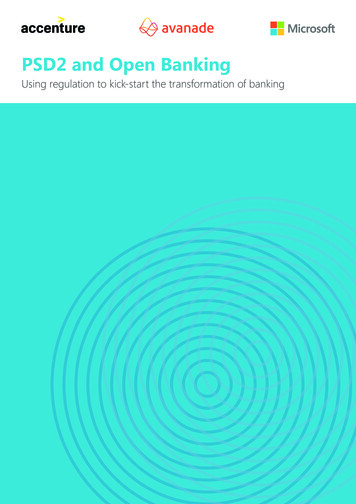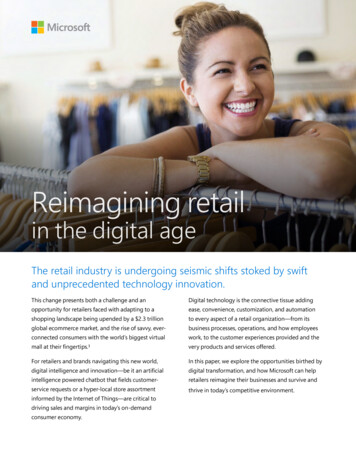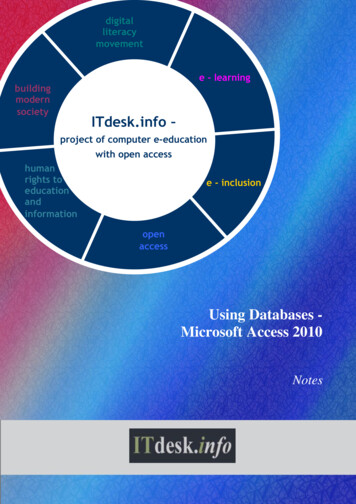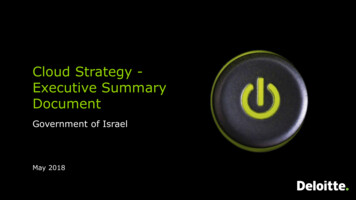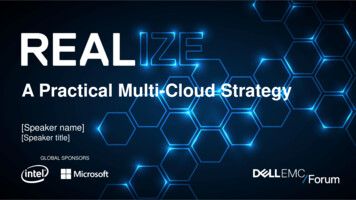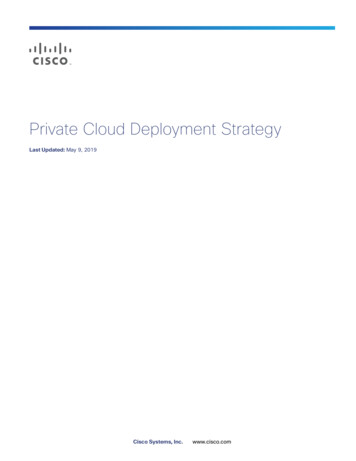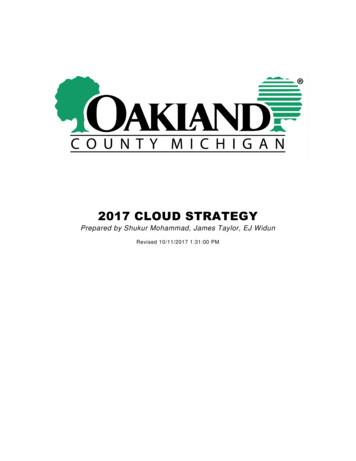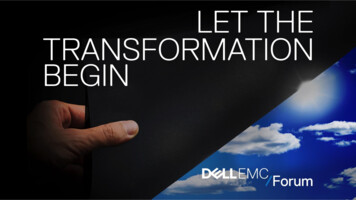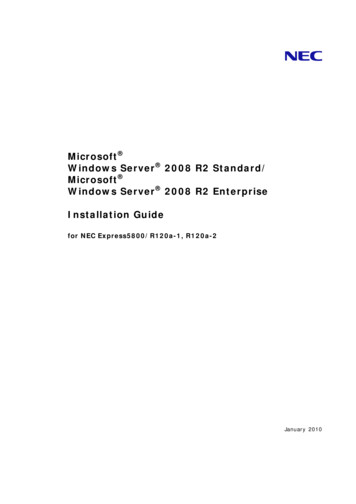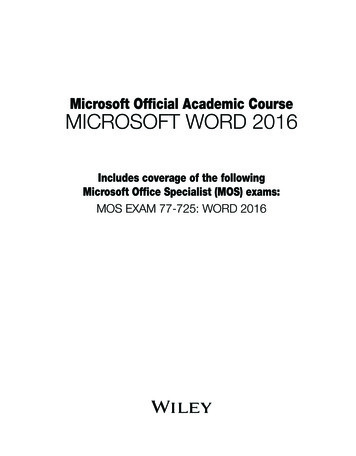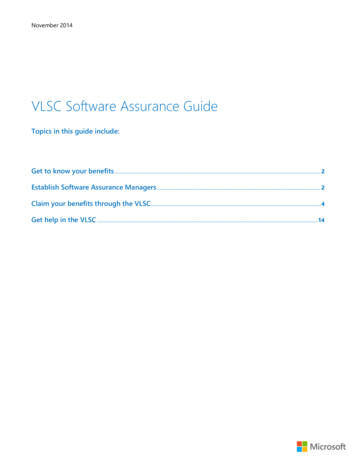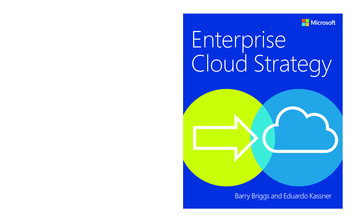
Transcription
Lead the journey to the cloud and driveinnovationImplemented through collaborative IT and business leadership,the infrastructure, applications, and services delivered throughthe hybrid cloud model can lead to a transformational processof innovation, efficiencies, and competitive advantage. Thiscollaborative journey to the cloud requires different skills,Barry Briggs is an author andconsultant. He was most recentlyChief Enterprise Architectfor the Microsoft DeveloperExperience team and previouslyChief Architect and CTO for theEnterprise Cloud StrategyEnterpriseCloud StrategyAbout the AuthorsMicrosoft IT organization.EnterpriseCloud StrategyEduardo Kassner is the Director ofCloud Solution Architecture in theWorldwide Enterprise and PartnerGroup at Microsoft.thinking, and culture for successful navigation. The process ofcloud migration also requires a plan and a solid understandingof the various components of a cloud strategy. This book showsyou how to assess your application portfolio, design the programsAlso look forand processes, and manage the organizational change as youmove your application catalog to the cloud.Yuri Diogenes, Jeff Gilbert,Robert MazzoliBriggsKassnerEnterprise Mobility with AppManagement, Office 365, andThreat Mitigation: Beyond BYODISBN: 978-1-5093-0133-1MicrosoftPressStore.com301966 CloudStrategy Briggs cover.indd 1Celebrating over 30 years!Barry Briggs and Eduardo Kassner11/23/2015 11:31:32 AM
Hear aboutit first.Get the latest news from Microsoft Press sent toyour inbox. New and upcoming books Special offers Free eBooks How-to articlesSign up today at MicrosoftPressStore.com/Newsletters
Visit us today atmicrosoftpressstore.com Hundreds of titles available – Books, eBooks, and onlineresources from industry experts Free U.S. shipping eBooks in multiple formats – Read on your computer,tablet, mobile device, or e-reader Print & eBook Best Value Packs eBook Deal of the Week – Save up to 60% on featured titles Newsletter and special offers – Be the first tohear about new releases, specials, and more Register your book – Get additional benefits
Free ebooksFrom technical overviews to drilldowns on special topics, getfree ebooks from Microsoft Press at:www.microsoftvirtualacademy.com/ebooksDownload your free ebooks in PDF, EPUB, and/or Mobi forKindle formats.Look for other great resources at Microsoft Virtual Academy,where you can learn new skills and help advance your careerwith free Microsoft training delivered by experts.Microsoft Press
EnterpriseCloud StrategyBarry BriggsEduardo Kassner
PUBLISHED BYMicrosoft PressA division of Microsoft CorporationOne Microsoft WayRedmond, Washington 98052-6399Copyright 2016 by Microsoft CorporationAll rights reserved. No part of the contents of this book may be reproduced or transmitted in anyform or by any means without the written permission of the publisher.Library of Congress Control Number:ISBN: 978-1-5093-0196-6Printed and bound in the United States of America.First PrintingMicrosoft Press books are available through booksellers and distributors worldwide. If you needsupport related to this book, email Microsoft Press Support at mspinput@microsoft.com. Please tell uswhat you think of this book at http://aka.ms/tellpress.This book is provided “as-is” and expresses the author’s views and opinions. The views, opinions andinformation expressed in this book, including URL and other Internet website references, may changewithout notice.Some examples depicted herein are provided for illustration only and are fictitious. No real associationor connection is intended or should be inferred.Microsoft and the trademarks listed at ctualProperty/Trademarks/EN-US.aspx are trademarks of the Microsoft group of companies. Allother marks are property of their respective owners.Acquisitions Editor: Karen SzallDevelopmental Editor: Karen SzallEditorial Production: Dianne Russell, Octal Publishing, Inc.Copyeditor: Bob Russell, Octal Publishing, Inc.Cover: Twist Creative Seattlei
ContentsIntroduction . ivAcknowledgments . ivErrata, updates, & book support . ivFree ebooks from Microsoft Press . vWe want to hear from you . vChapter 1: The cloud, efficiency, and innovation. 1Economics of the cloud . 1Daily efficiencies . 3Innovation . 3Telenor. 4Aviva . 53M Parking Systems . 6Heineken. 7Learnings . 7Chapter 2: Journey to the cloud: the roadmap . 9Don’t miss the opportunity to modernize . 10Evolution of the five R’s of modernization . 11Cloud migration: three stages . 12Chapter 3: Experimentation . 14Microsoft IT’s first cloud application . 14Experimentation and the problem of “shadow” IT . 15Chapter 4: Migrating IT to the cloud . 18Establish strategy and goals . 18Organizational responsibilities in creating the strategy. 22Enterprise architecture . 22Information security and risk management . 23Data classification . 24Enterprise Risk Management. 25Finance . 25i
Operations . 26Human resources and the evolution of roles . 27Applications teams . 29Business units . 30Building the catalog. 30Top-down portfolio analysis . 31Bottom-up portfolio analysis . 33The cloud migration plan . 35Microsoft IT’s experience . 37Cloud governance . 38Data governance . 38Financial governance . 39Security and compliance . 40Change management . 40Information Technology Infrastructure Library and the cloud. 41Chapter 5: Transformation . 43Platform as a Service architecture . 43Containers and microservices . 44Storage. 44Relational databases in the cloud. 45NoSQL (nonrelational) storage . 46Analysis . 49Integration . 52Using services to create rich end-to-end applications . 53Conclusions . 55Appendix A: Cloud architectural blueprints . 57Data analytics . 57BI and analytics . 59Live media streaming . 61Video on demand (VOD) . 63Line-of-business applications in infrastructure services . 65Hybrid cloud storage. 67E-commerce website . 68Business-to-business (B2B) e-commerce . 70Multichannel marketing . 72DevOps . 73Appendix B: Sample technology scenarios . 76Hybrid cloud scenarios . 76
Hybrid cloud connectivity . 76Using the cloud for data backup and recovery . 78Hybrid database scenarios . 81Development and test . 82Application development . 82Microsoft SharePoint . 83High availability in the cloud. 83Connected devices . 85Identity and authentication . 86Mobile applications . 88Enterprise mobility management . 89Websites . 90Azure Media Services . 92Migration strategies. 93Appendix C: Recommended references . 95Storage references. 95Application development and insights references . 95Performance best practices references . 95Other cloud migration references . 96About the authors . 97
IntroductionWhen briefing CIOs and senior IT executives at Microsoft, we are often told that migrating ITworkloads to the cloud ranks among their highest priorities. That statement is almost inevitablyfollowed by “How do I start?”; “How should I build a plan for cloud migration for my entire portfolio?”;and “How will my organization be affected by this change?”This book, based on real-world cloud experiences by enterprise IT teams, seeks to provide answers tothese questions. Here, you’ll see what makes the cloud so compelling to enterprises; with whichapplications you should start your cloud journey; how your organization will change, and how skillsets will evolve; how to measure progress; how to think about security, compliance, and business buyin; and how to exploit the ever-growing feature set that the cloud offers to gain strategic andcompetitive advantage.AcknowledgmentsThe authors wish to express their deep gratitude to the following individuals for their support,guidance, and their willingness to freely share their expertise: Scott Woodgate, Javier Nino, TomSchinder, Venkat Gattamneni, Martin Vliem, Ulrich Homann, Robert Hanegraaff, John Devadoss,Brenda Carter, Michael Washam, Zoiner Tejeda, Nadia Matthews, Rob Beddard, Jeff Fryling, Kevin Gee,Colin Nurse, Raman Johar, Walter Myers, Uwe Hoffman, Ashish Sharma, Ashutosh Maheshware, RichNickerson, Michel Declercq, Arlindo Alves, Dennis Mulder, and George Moore.Rob Boucher and Monica Rush created the graphic representations of the blueprints in theAppendixes.Errata, updates, & book supportWe’ve made every effort to ensure the accuracy of this book and its companion content. You canaccess updates to this book—in the form of a list of submitted errata and their related corrections—at:http://aka.ms/ECS/errataIf you discover an error that is not already listed, please submit it to us at the same page.If you need additional support, email Microsoft Press Book Support at mspinput@microsoft.com.Please note that product support for Microsoft software and hardware is not offered through theprevious addresses. For help with Microsoft software or hardware, go to http://support.microsoft.com.ivIntroduction
Free ebooks from Microsoft PressFrom technical overviews to in-depth information on special topics, the free ebooks from MicrosoftPress cover a wide range of topics. These ebooks are available in PDF, EPUB, and Mobi for Kindleformats, ready for you to download at:http://aka.ms/mspressfreeCheck back often to see what is new!We want to hear from youAt Microsoft Press, your satisfaction is our top priority, and your feedback our most valuable asset.Please tell us what you think of this book at:http://aka.ms/tellpressWe know you’re busy, so we’ve kept it short with just a few questions. Your answers go directly to theeditors at Microsoft Press. (No personal information will be requested.) Thanks in advance for yourinput!Stay in touchLet’s keep the conversation going! We’re on Twitter: http://twitter.com/MicrosoftPress
CHAPTER1The cloud,efficiency, andinnovationMost people now agree that the cloud has become a core element of anyenterprise’s technology strategy. Indeed, in the past few years we haveseen the conversation around cloud adoption move from “if” to “when”and “how.” It is, in short, a fact of life.Nevertheless, it remains one of the most disruptive changes in computing in years, and it is worthreviewing what makes the cloud so compelling to enterprise IT. Its value proposition is many-faceted,ranging from significant cost savings over a traditional datacenter approach to the ability to quicklybuild robust, resilient applications that can scale up as traffic spikes, and scale down as it recedes.Economics of the cloudIn cloud computing, enterprises pay for what they use, much as they would a telecom provider. Ifdemand decreases and you no longer need capacity, you can turn off systems and you are notcharged. This simple model stands in stark contrast to the traditional model of enterprise computing,which is a capital-intensive function, requiring expensive datacenters, electricity, air conditioning,servers, networks, storage, and 24x7 operations staff. For most companies, maintaining a large ITpresence in this model implies large capital expenditures and a nontrivial amount of accounting andrecord-keeping to track depreciation, tax considerations, and so forth. Moreover, when you purchasethe hardware and the software, they become yours in every sense of the word. Operations staffs areresponsible for hardware swaps, networks, backups, updates for operating systems, and upgrades tothe system software and applications. The traditional model is a “capital expense” model.The cloud, being subscription-based, is an operating expense model. In the cloud, computing becomesa service for which customers are billed a monthly charge. Like other such services, it is metered byusage. The more compute, network, and storage resources that you use, the higher will be your bill. Ofcourse the reverse is also true: the less you use, the less you are charged. Indeed, most ITorganizations find wide variations in system utilization: some applications (for example, retail1CHAP TER 1 The cloud, efficiency, and innovation
shopping) are seasonal; other applications (for example, training applications) run for a short period oftime before being shut down; others are simply unpredictable. The cloud addresses this variability(shown in Figure 1-1) perfectly via its “pay for what you use” model.Figure 1-1: Common application utilization models(It is worth mentioning that in the on-premises datacenter, the maximum utilization must be plannedfor and provisioned, which is financially far more inefficient than in the cloud.)But, there is more to it. Operating in the cloud frees enterprises of the mundane tasks of systembackup, network maintenance, patches, and software upgrades, because the cloud provider canhandle these in their entirety. The cloud provider in turn is heavily incented to utilize and in manycases pioneer best practices for system maintenance; the benefits are then passed to the customer.Moreover, cloud providers such as Microsoft can achieve economies of scale by buying hardware inmassive bulk, tens of thousands of servers at a time, for example. Very large datacenters hostingpublic clouds can also achieve economies in purchasing other resources; cloud datacenters pay only aquarter of the average cost of electricity in the United States. Figure 1-2 shows how overall total costof ownership (TCO) per server declines dramatically at scale.2CHAP TER 1 The cloud, efficiency, and innovation
Figure 1-2: Economies of scale in the cloudThese savings can, and are, passed on to customers of the cloud service.1 Indeed, although an ITdepartment can certainly create a private (internal) cloud of a thousand or so servers, using the publiccloud can result in savings up to ten times!2Later, we will discuss how IT departments can quantify the savings they can expect to achieve byadopting cloud computing.Perhaps most important, the cloud is not an “either/or” proposition. It is certainly possible, and indeedin many cases desirable, to leave some applications running in a local, traditional datacenter whileothers are migrated to the cloud. Providers such as Microsoft have made huge investments in thishybrid cloud model that securely connects applications in the cloud to those remaining in acustomer’s datacenter.Daily efficienciesAfter there is an on-demand computing service available, all sorts of other efficiencies becomepossible. For example, systems devoted to development and application testing often constitute alarge cost area for IT departments, yet in the end do not actually provide any direct value to endusers. With the cloud, developers and testers can quickly allocate cloud-based resources, use them fortheir work, and then free them up when done. Similarly, with the vast, capacious amounts of cheapstorage available in the cloud, data backup to the cloud, and across multiple geographies if desired,becomes a straightforward and inexpensive function. We will cover more of these in the course of thebook.InnovationOf course, at the end of the day, the goal of any enterprise strategy is to create competitivedifferentiation and advantage, and little doubt remains that IT has become a key element in modernSee “Economics of the Cloud” skits/cloud/docs/TheEconomics-of-the-Cloud.pdf2 John Rex, CFO Microsoft North America, analyst presentation13CHAP TER 1 The cloud, efficiency, and innovation
strategy. IT now drives transformative innovation, enabling enterprises to compete more effectively byinstantiating processes that deliver ongoing competitive advantage.As we will see, the emergence of a global computing cloud heralds the arrival of entirely new classesof innovation across applications and markets. Indeed, such new forms of innovation can actuallytransform an organization, and a business.Transformational innovation drives a different culture and mindset than most organizations currentlyhave. Affecting both IT and the leadership of the enterprise as a whole, this culture requires a closealignment between IT and business leadership.In the next few pages, we will examine a number of case studies from various global companies, all ofwhich have reaped rewards by their use of the cloud. The first, Telenor, shows how even a simplemigration of on-premises applications can make it possible for it to be far more cost-effective in itsoperations. The second, Aviva, demonstrates how an insurance company used mobile phones and thecloud to create an innovative approach to dynamic insurance pricing. In a third case study, 3M ParkingSystems opted for a cloud-based solution when it needed a way to track its thousands of devices inthe field. Lastly, the beverage giant Heineken chose the cloud as a way to deliver a global mediacampaign tied in with the release of a major motion picture, and the following year, with majorsporting events.TelenorThe Telenor Group is a Norwegian telecommunications company with worldwide operations servingalmost 150 million mobile subscribers. To modernize its intranet and collaboration sites and deliverbetter search within and across business units, Telenor will soon migrate from the MicrosoftSharePoint 2007 web application platform to SharePoint 2013. With 13 different business units spreadacross 12 countries, Telenor’s prime business objectives were to improve collaboration and bestpractice sharing, bolster process efficiency, and facilitate a more agile and responsive organization.Through the enhanced capabilities of SharePoint 2013, Telenor could also reduce significantly thecomplexity and maintenance cost of the 150-plus custom features installed on its IT network. Thatnetwork, with approximately 40,000 users, utilizes two SharePoint farms to support more than 20,000site collections, 70 web applications, and 100 content databases.Telenor’s IT structure is highly distributed across its business units, with ownership of corporate-wideinitiatives held by a central team
Cloud Solution Architecture in the Worldwide Enterprise and Partner Group at Microsoft. Enterprise Cloud Strategy Enterprise . Books, eBooks, and online resources from industry experts . Download your f
